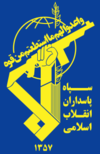Mohammad Ali Jafari
Sardar Mohammad Ali Jafari | |
|---|---|
 | |
| Nickname(s) | Aziz Jafari Ali Jafari |
| Born | 1 September 1957 Yazd, Iran |
| Allegiance | Iran |
| Service/ | Islamic Revolutionary Guard Corps |
| Years of service | 1981–2019 |
| Rank | Major general |
| Commands held | Ground Forces |
| Battles/wars | Iran–Iraq War (WIA) Iran–PJAK conflict 2016 West Iran clashes |
| Awards | |
Major General Mohammad Ali Jafari (Persian: محمدعلی جعفری, born 1 September 1957, also known as Aziz Jafari[2] and Ali Jafari[3]) is a former commander-in-chief of the Iranian Revolutionary Guard Corps from 2007 to 2019. He was appointed by Supreme Leader Ali Khamenei on September 1, 2007, succeeding Major General Yahya Rahim Safavi.[4]
According to a September 2, 2007, report by Radio Free Europe, Radio Farda has described Jafari has been close to the conservative subfaction, which includes Mohsen Rezaee, the secretary of the Expediency Discernment Council and former commander of the IRGC and Mohammad Bagher Ghalibaf, a former IRGC member and the mayor of Tehran. The replacement of Safavi was thought to be a move to strengthen the conservative faction as a counterweight to the radicalizers around President Mahmoud Ahmadinejad, whom Safavi is close to.[3]
"Observers appear to regard Jafari as principally a tactician, organizer, and 'technical' military man," according to Radio Free Europe.[3] The EU's official journal said the three Iranian Revolutionary Guard members, Jafari, General Qasem Soleimani, and the Guard's deputy commander for intelligence, Hossein Taeb, were now subject to sanctions and had been "providing equipment and support to help the Syrian regime suppress protests in Syria".[5]
Biography[]
Jafari was born in Yazd and completed his primary and secondary education there. In 1977 he was admitted to Tehran University, where he studied civil (construction) technology. As a student he participated in anti-Shah protests in Tehran, and was arrested and sent to jail for this. He represented his university department in the Islamic Organization of Tehran University.[2]
At the start of the Iran–Iraq War Jafari fought with the Basij paramilitary force. In 1981 he became a part of the Revolutionary Guards where he rose to serve as a commander of operative battlefields of south and west during the early 1980s. He also participated as an assistant[clarification needed] in the operation of Susangerd, and served as commander of the Ashura Battalion, as well as of the Garrisons of Qods and Najaf.[2]
After the war Jafari returned to university to complete his education, and in 1992 he received a degree in civil (construction) technology. In 1992 and 1993, he taught at the War University of the Revolutionary Guards.[6] He was appointed to head "a strategic research center to map out new defensive and military strategies in response to what Iran's leadership has seen as evolving threats in the Middle East", according to Radio Free Europe/Radio Liberty. Jafari is said to have formed many of his ideas on unconventional, or asymmetric warfare at the research center.[3]
Prior to his appointment as leader of the guards, he was also the commander of in Tehran.[6] In 1999, according to Radio Farda, Jafari was among 24 IRGC commanders who signed a letter to President Mohammad Khatami, warning him that his liberalizing policies at a time of civil unrest in Tehran, threatened the country's leadership.[3]
Jafari is a brother-in-law of Mohammad Bagher Zolqadr, a former deputy interior minister.[3]
Asymmetrical warfare knowledge and ties to Iraq[]
Jafari's work on asymmetrical warfare strategies include the use of Iranian terrain in mobile-defensive operations and rely on lessons and experiences learned in the Iran–Iraq War. Jafari said in Tehran on September 3, 2007, given "the enemy's" numerical or technological superiority, the IRGC would use asymmetrical warfare capabilities such as those used by Hezbollah in its 2006 conflict with Israel in Lebanon. Iranian strategy would also reflect the strengths and weaknesses of U.S. forces in Afghanistan and Iraq, he said.[3]
On September 2, 2007, Radio Farda reported Jafari has extensive fighting experience and reportedly close relations with the commanders of the former Badr Brigades of the Supreme Council of the Islamic Revolution in Iraq (SCIRI).[3]
See also[]
References[]
- ^ Poursafa, Mahdi (January 20, 2014). گزارش فارس از تاریخچه نشانهای نظامی ایران، از «اقدس» تا «فتح»؛ مدالهایی که بر سینه سرداران ایرانی نشسته است [From "Aghdas" to "Fath": Medals resting on the chest of Iranian Serdars]. Fars News (in Persian). Archived from the original on January 21, 2014. Retrieved October 21, 2014.
- ^ Jump up to: a b c "Iran changes Revolutionary Guards commander". Reuters. September 1, 2007. Retrieved September 2, 2007.
- ^ Jump up to: a b c d e f g h Sepehri, Vahid. "Iran: New Commander Takes Over Revolutionary Guards". Radio Free Europe/Radio Liberty. Archived from the original on October 20, 2008. Retrieved October 17, 2007.
- ^ "Commander-in-chief of Sepah". farsnews.com. Retrieved 4 February 2019.
- ^ "Syria: Deadly protests erupt against Bashar al-Assad". BBC News. June 24, 2011. Archived from the original on June 24, 2011. Retrieved June 24, 2011.
- ^ Jump up to: a b "Archived copy" فرمانده جديد سپاه پاسداران کيست؟ - ابتکار. Ebtekar (in Persian). September 2, 2007. Archived from the original on October 28, 2014. Retrieved October 28, 2014.CS1 maint: archived copy as title (link)
External links[]
| Wikimedia Commons has media related to Mohammad Ali Jafari. |
- 1957 births
- Living people
- Iranian military commanders
- Islamic Revolutionary Guard Corps personnel of the Iran–Iraq War
- Islamic Revolutionary Guard Corps major generals
- University of Tehran alumni
- People from Yazd
- Recipients of the Order of Fath
- Iranian engineers
- Iranian individuals subject to the U.S. Department of the Treasury sanctions
